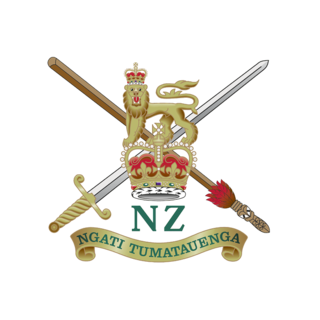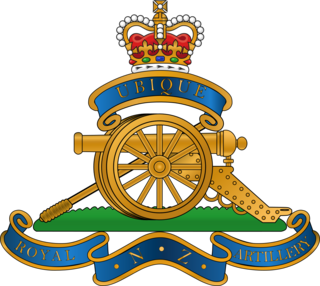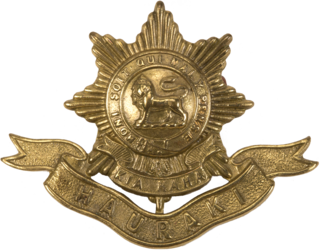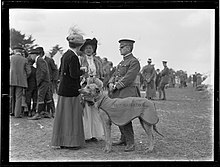
The New Zealand Expeditionary Force (NZEF) was the title of the military forces sent from New Zealand to fight alongside other British Empire and Dominion troops during World War I (1914–1918) and World War II (1939–1945). Ultimately, the NZEF of World War I became known as the First New Zealand Expeditionary Force. The NZEF of World War II was known as the Second New Zealand Expeditionary Force (2NZEF).

The Royal Regiment of New Zealand Artillery is the artillery regiment of the New Zealand Army. It is effectively a military administrative corps, and can comprise multiple component regiments. This nomenclature stems from its heritage as an offshoot of the British Army's Royal Artillery. In its current form it was founded in 1947 with the amalgamation of the regular and volunteer corps of artillery in New Zealand. In 1958 in recognition of services rendered it was given the title the Royal Regiment of New Zealand Artillery.

The Hauraki Regiment was a Territorial Force unit of the New Zealand Army. The regiment was formed as the 2nd (Hauraki) Battalion, Auckland Rifle Volunteers. Men of the Hauraki Regiment served during the First World War with the various Auckland Regiments, and with the 18th, 21st, 24th and 29th Battalions of the NZEF in the Second World War.

The Waikato Mounted Rifles (WMR) is the New Zealand Army's only Territorial Force squadron of the Royal New Zealand Armoured Corps (RNZAC). The Squadron's origins can be traced back to 1869 when the first mounted unit was raised in the Waikato. Today the Squadron is part of Queen Alexandra's Mounted Rifles (QAMR) where it forms the regiment's reserve squadron. WMR's role is mounted reconnaissance and surveillance.
The 3rd Battalion, Auckland and Northland Regiment was a Territorial Force Battalion of the Royal New Zealand Infantry Regiment, with headquarters in Arch Hill Auckland Army Centre. The unit consists of company-sized units which have their headquarters in Auckland and Whangarei. The unit was part of Training and Doctrine Command (TRADOC) headquartered at Waiouru.
The Otago and Southland Regiment (1948-2012) was a Territorial Force unit of the New Zealand Army. It saw service from 1959-1963 during the Malayan Emergency. In 1964 the unit was renamed the 4th Otago and Southland Battalion Group. The Regiments motto was Kia Mate Toa and Regimental Belt had the Mackenzie Tartan pattern of the Queen's Own Highlanders. The regimental badge uniquely contained a full Māori chief.

The Sherwood Foresters was a line infantry regiment of the British Army in existence for just under 90 years, from 1881 to 1970. In 1970, the regiment was amalgamated with the Worcestershire Regiment to form the Worcestershire and Sherwood Foresters Regiment, which in 2007 was amalgamated with the Cheshire Regiment and the Staffordshire Regiment to form the present Mercian Regiment. The lineage of the Sherwood Foresters is now continued by The Mercian Regiment.

The 1st Brigade is currently the largest unit of the New Zealand Army, and contains most of the army's deployable units. The brigade was formed on 13 December 2011 by amalgamating the 2nd Land Force Group and 3rd Land Force Group. Its establishment formed part of the 'Army 2015' package of reforms.
The 4th Infantry Brigade was a formation of the New Zealand Military Forces, active in both the First and Second World Wars. It was initially raised in England in 1917 for service with the New Zealand Division on the Western Front during the First World War. It only fought in one major engagement, the Battle of Broodseinde, although it was in reserve for two other significant battles, the Battle of Messines and the First Battle of Passchendaele. The brigade was disbanded in early 1918 due to a reorganisation of the New Zealand Division.
The 1st Division was one of three New Zealand Army home defence divisions formed during World War II. The unit was established on 1 November 1941 and was responsible for protecting the northern region of New Zealand's North Island from invasion. The 1st Division was placed on alert during the early months of the Pacific War, but no threat developed. The division was greatly reduced in size during 1943 and was disbanded on 1 April 1944.
The 4th Division was one of three home defence divisions of the New Zealand Military Forces formed during World War II. The unit was established on 1 November 1941 and was responsible for protecting the southern part of New Zealand's North Island from invasion. The division was greatly reduced in size during 1943 and was disbanded on 1 April 1944 without seeing combat.
The 2nd Infantry Brigade was a formation of the New Zealand Military Forces raised for service abroad with the New Zealand Expeditionary Force during the First World War. As part of the New Zealand Division, it participated in several major battles on the Western Front from 1916 to 1918 before being disbanded in 1919. There was also a 2nd Infantry Brigade in the New Zealand Territorial Force that existed from 1924 to 1964.

The Taranaki Regiment was a territorial infantry regiment of the New Zealand Military Forces. The regiment traced its origins to the Taranaki Volunteer Rifle Company, a volunteer corps formed in 1858 and which saw service in the New Zealand Wars. The volunteer corps also provided men to the New Zealand contingents sent to South Africa during the Second Boer War and in 1911 became the 11th Regiment (Taranaki Rifles). During the First World War, the regiment provided a company to each of the battalions of the Wellington Infantry Regiment and saw combat at Galipolli and on the Western Front. After the war the regiment was renamed the Taranaki Regiment and remained in New Zealand for home defense during the Second World War. Men from the regiment, however, served with the 19th, 22nd, 25th and 36th Battalions of the Second New Zealand Expeditionary Force. In 1948, the Taranaki Regiment was amalgamated with the Wellington West Coast Regiment and became the Wellington West Coast and Taranaki Regiment.

The Wellington Regiment (City of Wellington's Own) was a territorial infantry regiment of the New Zealand Army. The regiment traced its origins to the Wellington Veteran Volunteer Corps, a volunteer corps formed in 1867 and which would later amalgamate with other volunteer corps to form the 5th (Wellington) Regiment in 1911. During the First World War, the regiment was first sent to capture German Samoa in August 1914 and was later affiliated with the New Zealand Rifle Brigade which saw combat on the Western Front. After the war, the regiment was renamed the Wellington Regiment and remained in New Zealand for home defence during the Second World War. Men from the regiment, however, served with the 19th, 22nd, 25th and 36th Battalions of the Second New Zealand Expeditionary Force. In 1964, the Wellington Regiment was amalgamated with the Hawke's Bay Regiment to become 7th Battalion (Wellington (City of Wellington's Own) and Hawke's Bay), Royal New Zealand Infantry Regiment. The 7th Battalion was itself later amalgamated with the 5th Battalion and became 5th/7th Battalion, Royal New Zealand Infantry Regiment in 2012. The traditions of the Wellington Regiment are now continued by Wellington Company, 5/7 RNZIR.

The 2nd Māori Battalion was a territorial battalion of the New Zealand Military Forces during the Second World War. The battalion was formed in February 1942 as the 3rd battalion, North Auckland Regiment by converting a battalion of the National Military Reserve. The 2nd Māori Battalion garrisoned fortress areas in Northland and also provided training for personnel who would be latter posted overseas with 28th (Māori) Battalion. It was disbanded in 1944 along with most other territorial units.

The Hawke's Bay Regiment was a territorial infantry regiment of the New Zealand Military Forces. The regiment traced its origins to the Napier Rifle Volunteer Rifles, a volunteer corps formed in 1863 and which would later amalgamate with other volunteer corps to form the 9th Regiment in 1911. During the First World War, the regiment provided a company to each of the battalions of the Wellington Infantry Regiment and saw combat at Galipolli and on the Western Front. After the war the regiment was renamed the Hawke's Bay Regiment and remained in New Zealand for home defense during the Second World War. Men from the regiment, however, served with the 19th, 22nd, 25th and 36th Battalions of the Second New Zealand Expeditionary Force. The regiment had a close relationship with the Ruahine Regiment, which was detached and reabsorbed by the Hawke's Bay regiment on two separate occasions. In 1964, the Hawkes Bay regiment was amalgamated with the Wellington Regiment and become the 7th Battalion, Royal New Zealand Infantry Regiment

The Ruahine Regiment was a Territorial Force Infantry Regiment of the New Zealand Military Forces. It was briefly raised in the 1910s and saw service in the First World War as part of the Wellington Infantry Regiment. It was formed for a second time during the Second World War and was deployed overseas as part of the 3rd Division but never saw combat.

The New Zealand Scottish Regiment was a regiment of the New Zealand Army. It was formed in 1939 as an infantry regiment and raised two battalions during the Second World War. Although the 1st Battalion was sent overseas during the war as part of the 3rd Division, it never saw combat. The regiment was reformed in 1948 as a reconnaissance regiment of the Royal New Zealand Armoured Corps, but by the 1960s had been reduced to two independent squadrons. Various armoured vehicles were utilised by the regiment including Daimler Dingo Scout Cars, Daimler Armoured Cars, Ferret armoured cars and M113a1 armoured personnel carriers. The regiment was eventually disbanded in 2013.
The Wellington West Coast Regiment was a territorial infantry regiment of the New Zealand Military Forces. The regiment traced its origins to the Wanganui Rifle Volunteers, a volunteer corps formed in 1860. The volunteer corps provided men to the New Zealand contingents sent to South Africa during the Second Boer War and in 1911 became the 7th Regiment. During the First World War, the regiment provided a company to each of the battalions of the Wellington Infantry Regiment, which saw combat at Galipolli and on the Western Front. After the war the regiment was renamed the Wellington West Coast Regiment and remained in New Zealand for home defence during the Second World War. Men from the regiment, however, served with the 19th, 22nd, 25th and 36th Battalions of the Second New Zealand Expeditionary Force. In 1948, the Wellington West Coast Regiment was amalgamated with the Taranaki Regiment and became the Wellington West Coast and Taranaki Regiment.

The Northland Regiment was a territorial infantry regiment of the New Zealand Military Forces. The Regiment was formed in 1911 and provided service companies to the Auckland Infantry Regiment during the First World War. Men from the Regiment also served with the 18th, 21st, 24th and 29th battalions of the 2nd New Zealand Expeditionary Force during the Second World War. The regiment was amalgamated with the Auckland Regiment in 1964, becoming 3rd Battalion, Royal New Zealand Infantry Regiment.















